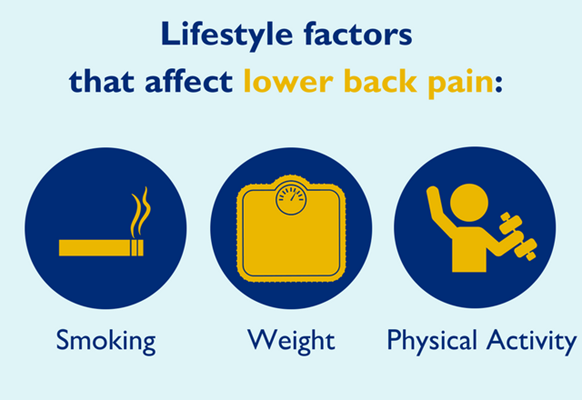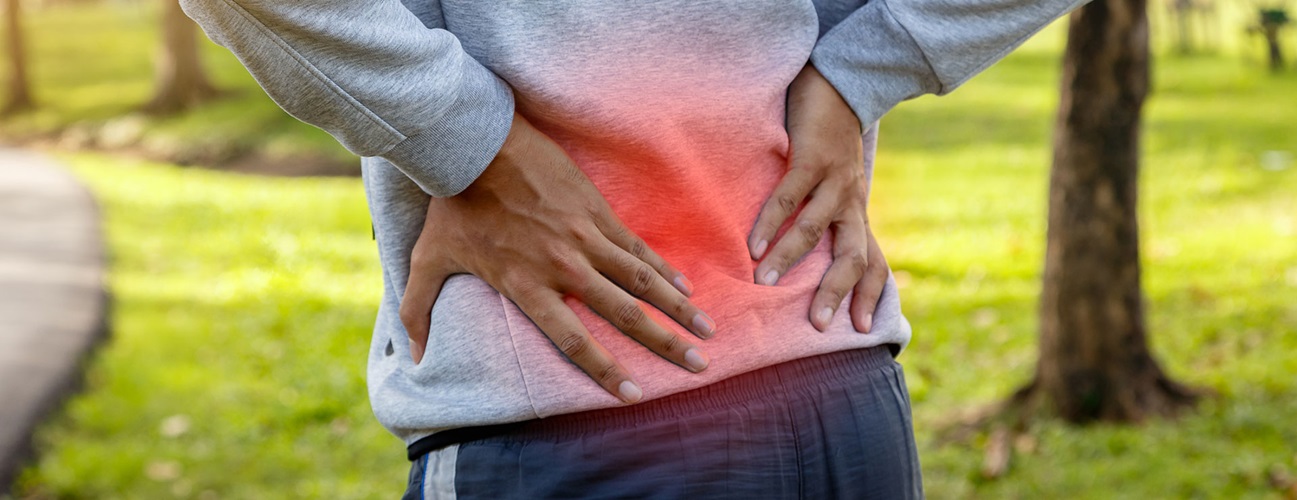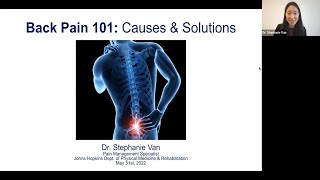Lower Back Pain: What Could It Be?
Featured Expert
Do you have lower back pain? You are not alone. Anyone can experience lower back pain at any time, even if you don’t have a prior injury or any of the risk factors. It is not always serious and can often get better on its own. But in some cases pain is your body’s way of telling you that something isn’t right.
Learn more about lower back pain and what causes it from rehabilitation physician Akhil Chhatre, M.D., who specializes in back pain in the Johns Hopkins Department of Physical Medicine and Rehabilitation.
Why is lower back pain such a common problem?
The bottom part of your back typically has just five vertebrae — fewer than your neck and mid-back. And these vertebrae do a lot of heavy lifting! Your lower back is where your spine connects to your pelvis, bearing the weight of your upper body. This area experiences a lot of movement and stress, which may lead to wear, tear and injuries.
What are some common causes of lower back pain?
Arthritis of the Spine
Arthritis of the spine — the slow degeneration of the spinal joints — is the most frequent cause of lower back pain. All of us experience wear and tear as we age, and it is normal for your lower back to start acting up as you get older. As the cartilage breaks down between the spinal joints, surrounding tissues may become inflamed. The inflammation and the thinning of cartilage increase friction in the joints, which may cause pain in the lower back.
Back Injuries
A bad fall or a car accident can cause a lower back injury. But so can carrying a laundry basket up the stairs. Some back injuries can be sudden and traumatic, and some happen slowly over time. You may think that athletes and active people get injured the most due to their active lifestyle. “But this is not always the case,” Chhatre says. You are just as likely to tweak your back while bending over to pick up a sock from under the bed. It’s the everyday tasks, like holding a child, that may lead to back injuries when done improperly.
Herniated Discs
A herniated, or bulging, disc is a disc that has “spilled out” of its lining. This happens most frequently in the lower back. The injured disc may not always hurt. But even if it’s painless, its contents can press on or irritate nearby nerves, causing pain in the lower back and other areas.
Which lifestyle factors contribute to lower back pain?

There are three major lifestyle factors that may affect your chances of developing lower back pain:
- Multiple studies have established a link between smoking and lower back pain. Smoking raises inflammation inside the body and hinders the body from healing itself.
- Obesity is also associated with several types of chronic pain, including lower back pain. In people with high body mass index (BMI), the stress on the spine increases, contributing to even more wear and tear.
- Your level of physical activity can also play a role in your lower back health. While a sedentary lifestyle could increase your risk of developing lower back pain, so can excessive or strenuous physical activity. Check with your doctor if you are unsure about your ideal level of physical activity.
Can lower back pain be related to weather?
If you feel like your lower back pain worsens on days when it’s cold or the weather is changing, you are not imagining things. Back pain can indeed be related to barometric pressure and outdoor temperature. Changes in pressure can sometimes cause pain in arthritic joints, including the spine. Muscles and joints in general react to the environment, which can make them stiffer and more likely to suffer an injury.
Could lower back pain be kidney pain?
It absolutely can. Kidneys are located on the back side of your body and kidney pain can sometimes feel like back pain. The only true way to tell the difference is to visit a doctor who can conduct a thorough examination.
Back Pain Causes and Treatments Webinar | Stephanie Van, M.D.
Chronic back pain is a persistent source of discomfort for many adults. In this webinar, our expert Stephanie Van, M.D., discusses common causes of back pain along with strategies for relief.
What does it mean if lower back pain is shooting into legs?
Lower back pain can radiate to other parts of the body: up or down from its place of origin. Sometimes lower back pain can be on one side of the back, which is also normal.
If the pain is shooting from the lower back into one or both legs, it could be sciatica (nerve pain), but it’s not always the case. There are many parts in the lower back that may cause the pain to radiate into the legs, such as facet joints, sacroiliac joints, muscles or inflammation of the bursa.
Can lower back pain be a sign of something serious like cancer?
Lower back pain can be related to cancer. In fact, it is one of the first symptoms of prostate cancer when it metastasizes and creates lesions. Almost any cancer can spread to the back and some, like sarcoma, can originate in the back. Be cautious, especially if you are experiencing other symptoms besides lower back pain. Talk to your doctor if you have additional symptoms or concerns.
What can I do for low back pain at home?
If your lower back pain has just started, the best thing you can do is start a log. Record your symptoms, times, dates and which activities trigger the pain or make it worse or better. Take this information to your family physician if the pain doesn’t resolve on its own. It will make diagnosing the cause much easier.
Once you know which motion or position causes your lower back pain, try to avoid it and see if you get better. Icing the painful spot can also help. And so can over-the-counter pain relievers that help reduce inflammation. Just remember that pain killers treat only the symptom — pain — and not its cause.
When should I see a doctor if I have lower back pain?
In many cases lower back pain stops on its own. But if it doesn’t, here are some guidelines on when you may want to start seeking professional help:
- If the pain lasts four weeks or longer
- If the pain keeps getting worse as time goes by
- If you are experiencing other symptoms, such as fever, major weight loss or weight gain, loss of function or weakness in extremities, bladder problems, etc.
Who should I see for lower back pain?
Your primary care physician knows you best and should be your first contact for lower back pain. If he or she is unable to diagnose or treat the issue, you may get referred to a specialist, such as a rehabilitation physician (physiatrist). These specialists practice a comprehensive approach to lower back pain, and can diagnose and treat a variety of conditions that have lower back pain as a symptom.
Later, you may get referred to a physical therapist, a chiropractor or another practitioner depending on the nature of your back pain. The good news is that surgery is rarely needed for lower back pain. “Only about one in ten patients needs lower back surgery,” Chhatre says.








